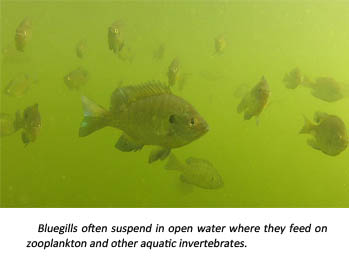Lessons in ecology from the humble bluegill: Part 1
The bluegill is one of the most common and popular fish in Michigan, and one of the best understood. For over a century, researchers have been studying the ecology of bluegill in Michigan lakes.
While some anglers go on to chase trophy muskellunge or cast tiny flies to rising trout, most begin their love of fishing with the aggressive nibble of the bluegill. The bluegill is small in size, but curious and notoriously spirited in nature. Many an angler has commented, “if bluegill weighed ten pounds no one would fish for anything else.”
Bluegills have long been a favorite subject of researchers, too. They are found in most inland lakes and exhibit complex relationships with their predators, prey, and competitors. The role of vegetation (weeds) in determining the nature of relationships between bluegills and other species is of particular interest.
One of the first studies involving bluegill in Michigan took place on Walnut Lake in Macomb County in 1906 and was published by the American Fisheries Society in
1911. The author, Thomas L. Hankinson, observed that bluegills used shallow bulrush flats for spawning. Bluegills built dish-shaped nests and aggressively
defended their eggs from minnows that gorged on the eggs of bluegill whenever possible. In the bulrushes and over deeper vegetation, bluegill fed on aquatic invertebrates including midge and
mayfly larvae. 
In the hundred-plus year since Hankinson’s early observations, we have learned a lot about how vegetation mediates the ecological relationships of bluegill. The influential work of Werner and Hall at MSU’s Kellogg Biological Station included a 1977 study that found small bluegill are confined to areas of dense vegetation because open areas expose them to predators like largemouth bass. Once bluegills grow large enough to present more than a mouthful for bass, they can stray from weed cover and feed more effectively on a wider range of food.
The density, species, and patchiness of vegetation can greatly influence the type of food available to bluegill and their risk of predation. In some lakes, extremely high weed density covering a high percentage of the lake can lead to stunting of bluegill. Stunted bluegill grow slowly, and in some cases, this is linked to the inability of predators to limit, effectively, the number of small bluegills competing amongst their own kind for limited food. In short, vegetation is important for protecting young bluegill, but too much protection can harm growth rates.
Even this generalization does not always hold true, though. In 1999, James C. Schneider, with the Michigan Department of Natural Resources, demonstrated that weedy lakes could grow large bluegill under some conditions. One of his study sites was a private lake that had 83% of its surface area covered with vegetation. Despite this, big bluegills (over eight inches) numbered more than 1,200 per acre. Schneider’s work suggested that low angling pressure, high numbers of small largemouth bass, and abundant food can result in impressive numbers of large bluegill in ‘weedy’ lakes.
Perhaps of all the ecological lessons offered by the bluegill, the most compelling is that nothing in nature’s web of interconnected life is simple. Not even the humble bluegill.
Bluegills: Biology and Behavior (American Fisheries Society book)



 Print
Print Email
Email


